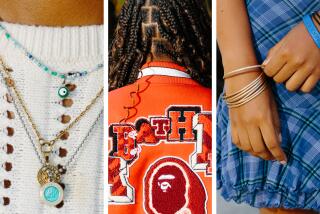Rebels Without Taste
- Share via
Your daughter wants to go to school without a jacket, even though the temperature is 40 degrees. Your son wants to adorn his hair with multicolored barrettes intended for toddler girls.
And you want to scream.
Battles over clothing and accessories are common between parents and early adolescents of both sexes, especially 11-, 12- and 13-year-olds. Some kids insist on wearing certain brands exclusively. Others dress in garb that is torn, spattered with obscene slogans or three sizes too big.
Oriented to the present, adolescents often buy fad apparel without thinking about its longevity. Many younger teens reject the clothes their parents buy them and discard pieces of their wardrobe after a single wearing just because someone made a negative remark about their appearance.
If these behaviors drive you crazy, try to understand the reasons behind them, experts in early adolescence recommend.
“The herd mentality reigns during the middle school and junior high years--a time kids go through a transition between being dependent on parents and standing on their own,” says Deborah Webb Blackburn, a clinical psychologist at Virginia Treatment Center for Children, part of the Medical College of Virginia in Richmond.
“To make the transition, kids have to feel like they are part of a group,” she says. “The way to belong at this age is to look like everyone else.”
Also, experimenting with clothing is one of the few ways young teens have to assert their independence and express their individuality.
Laurence Steinberg, co-author of “You and Your Adolescent” (HarperPerennial, 1990), explains, “Our [adult] decisions about what to wear are based in part on our desire to send a message to others about our values, attitudes and status--about who we are. Like adults, adolescents want to manage the impression they make on others. The only real difference is the audience they are playing to. The adolescent who insists on wearing jams to school because all his friends are surfers is really no different from his father who insists on wearing a navy pinstripe suit to the office. The boy and the adult are both saying through their appearance, ‘This is who I am.’ ”
Parents often argue with young teens about clothes because they believe that the way their kids look is a reflection on them. Many moms and dads fear that certain kinds of clothing will lead to drug use, sexual promiscuity and other dangerous behaviors.
“Parents look at the way their children are dressed and wonder, ‘Does this mean she’s getting in with a bad crowd or that she is turning into someone I don’t know?’ They get scared that they are going to lose their child,” Blackburn says.
*
Many parents object when early adolescents nag them for expensive designer clothes. “You have to understand that kids do this to be part of a group, but you don’t have to give in and buy them these clothes. Use their requests as opportunities to discuss the value of judging others by their character rather than their looks,” Blackburn says.
Refusing to dress for the weather is common among young teens, who say that jackets are unwieldy, boots “uncool.” They would rather be cold than face ridicule from their peers.
“Young teens sometimes wear clothes that are inappropriate for the temperature as a way of saying, ‘I can make my own decisions.’ Parents should respect that and let natural consequences rule. If a child gets cold one day, maybe he’ll wear a jacket the next day. Many parents think kids will catch cold if they don’t bundle up, but colds come from germs, not from being underdressed,” Blackburn says.
Here are some other tips for preventing clothing conflicts with your early adolescent:
* Lay off. “As long as your child does well in school, has friends and is active and involved in activities, the clothing she prefers is relatively unimportant,” says Robin Goldstein, author of “Stop Treating Me Like a Kid!” (Penguin, 1994). “The only need for concern is if your child isn’t generally doing well and seems to choose styles that antagonize you. This may be the sign of a deeper problem you need to pay attention to.”
* Accept that your child’s appearance is her own and does not reflect on your ability to be a good parent.
* Don’t shop for your child’s clothes without him. Chances are you’ll buy something he won’t wear. Consider asking him to take you on an “educational” shopping trip during which he shows you what he likes and explains why. Try not to be judgmental.
* Compliment your child on her appearance from time to time. “She still wants your approval, and constant criticism from you can harm her self-image,” Goldstein says.
* Compromise. If you and your child disagree about clothing, listen to his rationale without putting him down. Be willing to meet him halfway. For example, say, “You can wear baggy jeans but not T-shirts with swear words on them,” or “It’s OK to wear torn pants to a party, but not to school.” Consider having your child pay for clothes you don’t like.
* Focus on your child, rather than on her clothes. Show interest in her friends and activities and do fun things with her, such as going to the movies. If you are in touch with your young teen, you won’t have to worry that her clothing choices reflect involvement with a “bad crowd.”
* Be consistent. Advises Blackburn: “Once you’ve said it’s OK for your child to wear something, don’t roll your eyes each time he puts it on. If you can’t live with an item of clothing, let your child know upfront.”






